North Vietnam; Production and Thrift, 1953/1955 (Michel Nr. 7-8); Inflation was rampant in North Vietnam in the early to mid 1950’s. As a result the standard letter rate that had stood at 100 Dong until the end of 1951 moved up to 200 Dong in March of 1952, 400 Dong in September 1952 and then all the way up to 1,000 Dong in the middle of 1953. So initially it is a bit puzzling why the Government would decide to issue a stamp with a nominal of only 100 Dong on July 13th of 1953 as it would have required a minimum of 10 individual stamps to complete the standard letter rate. However, the matter resolves itself when one understands that these two stamps were the first ones that were already issued in a new currency (Dong Ngan Hang- Dong of the National Bank) that devalued the previous Dong from 1945 10:1 on June 5th, 1951. The new currency was introduced with the establishment of the National Bank of Vietnam which Ho Chi Minh created by decree 15/SL on May 6, 1951 (Democratic Republic of Vietnam Coin and Currency Catalogue, Howard Daniel). This means the new 100 Dong stamp was equivalent to 1,000 Dong of the old currency. Catalogue makers do not make that clear at all. The 500D stamp was issued a bit later in February 1955. Note that the date imprinted at the bottom of the stamp (1952) indicates the year when the stamps were designed/prepared. The issuance then happened much later. The stamps are again fairly primitive and they were produced at Viet Bac National Bank Printing Works. Sheet size was 100 for the 100D value and 180 for the 500D value.
Mint set in blocks of four.
There appear to be two printings of the 100D value whose color difference goes beyond pure shading due to uneven application of printing color onto the printing plate. It is thought that the first printing is that of the lighter violet color and the second printing (rarer) that the darker black-violet color.


Also a plate error is known on a partial printing of the 100D stamp. On the bottom right stamp the design year “1952” is totally missing.
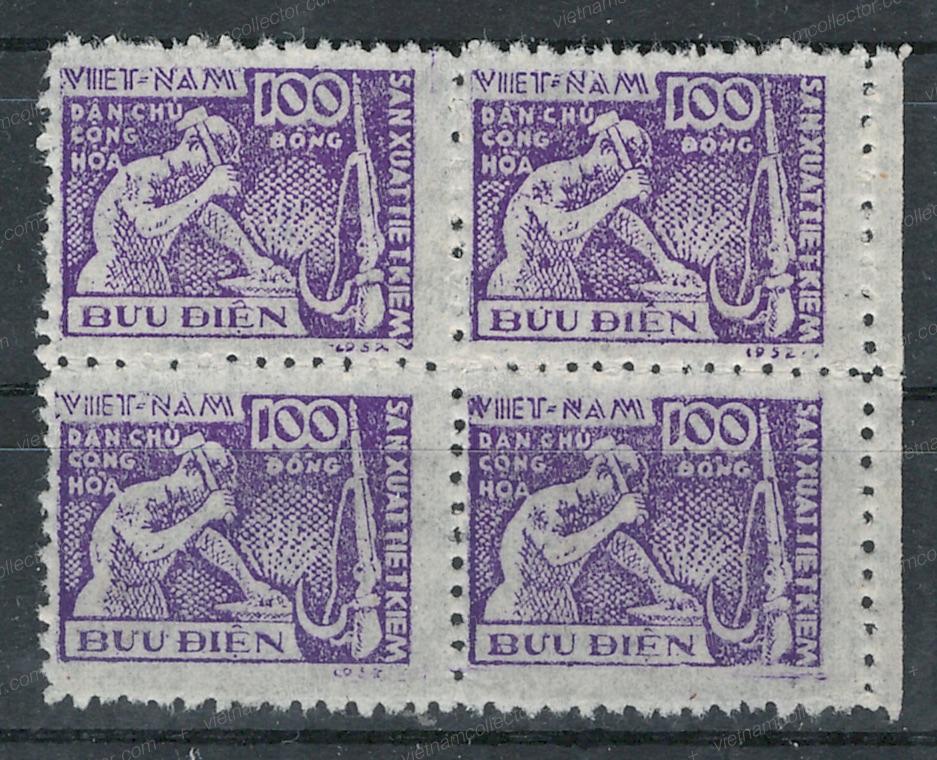
Detailed scan of the affected area.

This error appears to occur multiple times within the sheet (at least in a partial printing) as is evidenced by this piece of twelve 100D stamps. The year “1952” is missing on the entire second row from the top and on the first stamp in that row also part of the design above “1952” is missing. This may indicate a progressive failure of the printing plate.
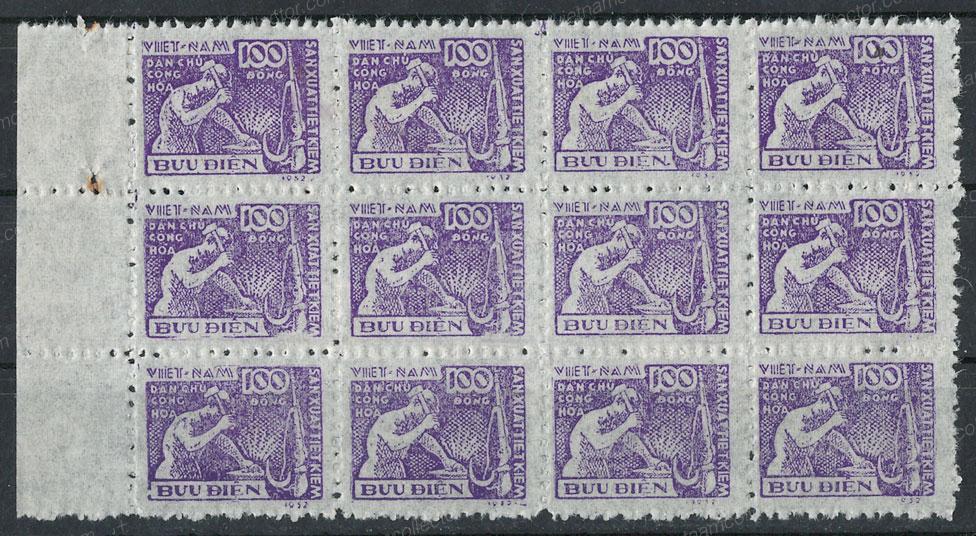
Detailed scan of the affected area.

A plate error is also known on the 500D value. On this mint block of four the bottom left stamp is showing parts of the letters AM in NAM missing.
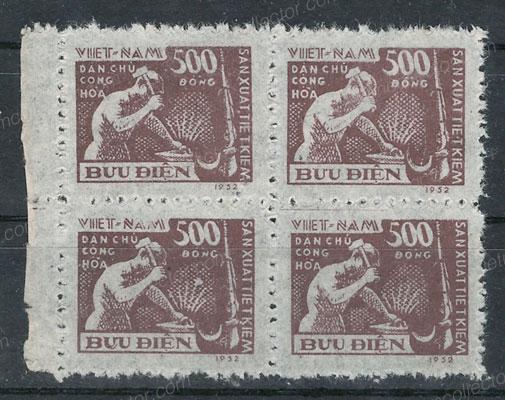
Detailed scan of the affected area.

On July 13th, 1953 postal authorities also issued a set with a similar image that was only intended for official mail between Government offices. Prior to the issuance of these stamps official mail was free of charge. Since inflation was rampant in the early 1950’s in Vietnam the Government decided that these stamps should be issue in “kilo of husked rice” which gave these stamps an automatic built in inflation protection. Four values were issued: 0.6 kg rice, 1 kg rice, 2 kg rice and 5 kg rice. The standard letter rate amounted to 0.6 kilo rice. The sheet confection was a bit unusual as the 0.6 kg rice stamp was issued in sheets of 100 while all the other values were issued with 180 stamps to the sheet. The Perforation was 11.5 and it was very poor. Given the very thin, cigarette like paper, hence all stamps show perforation imperfections.
Here is the mint set that curiously enough shows “1952” at the bottom of the image. May be this was the year the stamps initially were intended for issuance but according to the Vietnamese Postage Stamp Catalogue issuance did not occur until July, 1953. Note that the 5kg rice stamp shows the plate error “distorted K and broken 1 in 1952”.
This is the mint set of official stamps in blocks of four. Note that the top right 0.6kg rice stamp shows the plate error “six broken at bottom”. The top left 1kg rice stamp shows the plate error “k almost missing, the top right stamp the plate error “4th line on left broken in middle” and the bottom left stamp the plate error “white triangle pointing left under k”.
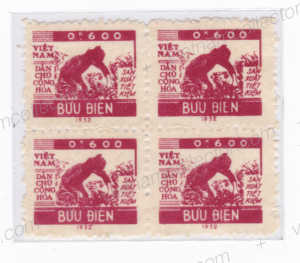
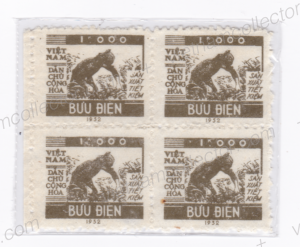
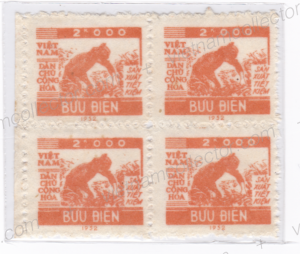
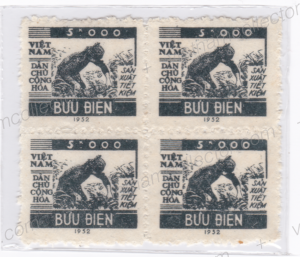 Rare postally used pair of the standard stamps.
Rare postally used pair of the standard stamps.
Two 100 Dong values on piece postally used
A scarce postally used block of six stamps probably from a large letter or package wrapper
Piece cut from a letter featuring one of the 500D stamps postally used.
Since it was against office regulations to take official stamps or envelopes from the office, postally used stamps virtually do not exist. Here is the most likely version you will see in a cancelled set. It carries the standard Hanoi date canceler and was cancelled to order.
The most likely way for postally used stamps to survive was on mail sent abroad. But even that was very rare in the early 1950’s. Here is a complete set postally used (extremely scarce). Note that the 0.6kg rice stamp shows the plate error of “broken c in CONG”.
A number of perforation error have become known on the 2,000D value. Here is a mint block of eight stamps that is imperforate on the horizontal plane. Note that the top right stamp shows the plate error “white dot under k missing entirely” and the bottom right stamp “O in CONG open at bottom left”.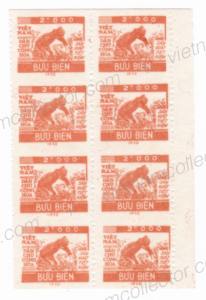
Here is a similar error but on this strip of four mint stamps the two top horizontal perforation lines are missing and the stamps are imperforate there.
These stamps were not officially released imperforate but a small number of imperforate trial proofs have come to market. Here is a mint imperforate pair. Note that the top stamp shows the plate error “broken T in VIET”.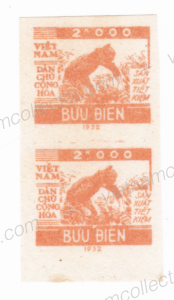
Here is a mint block of six stamps that were invalidated by a hand stamp “HUY BO” (=Destroyed). It was applied by postal authorities to ensure that the stamps would in fact be destroyed and not reused. So this block clearly should no longer exist but a crafty postal employee sold it anyway.
Very rare local letter made up of waste paper (adversity cover) mailed within Son La (located in the North-Western Highlands paying the new rate of 100 Dong that was effective from July 1st, 1953 (in New Dong = 1,000 Old Dong). The letter was sent on September 1st, 1953 as indicated by the manuscript entered into the cancel on front. Due to the tropical climate, severe material shortages and decades of warfare not many local letters of early North Vietnam survive. Backstamp “Buu Dien” (Post Office) without date entered.
Very rare domestic letter carrying a single 100D Production and Thrift stamp mailed by a person called Lê Trường to a Mr. Phôi that is working in the post office of Thừa Thiên. Thừa Thiên is a suburb of the coastal city of Hue. The cover was handmade of package paper and represents an “adversity cover” that was typical for the time. The stamp was cancelled with the new rectangular box cancel (illegible) that came in use at the beginning of 1952. The remark in parentheses states “Please transfer immediately to comrade Phôi. The letter was also marked with a manuscript T10H (which stands for 10 Hao or 100D) indicating that the letter was underpaid. The postal tariff for a standard domestic letter in North Vietnam was raised in October of 1954 from 100D to 150D. The letter therefore must have been mailed after October of 1954. It was short by 50 New Dong and together with the 50D penalty a 100D or 10 Hao postage due was assessed. Very few of these early domestic letters have survived the ravages of time.
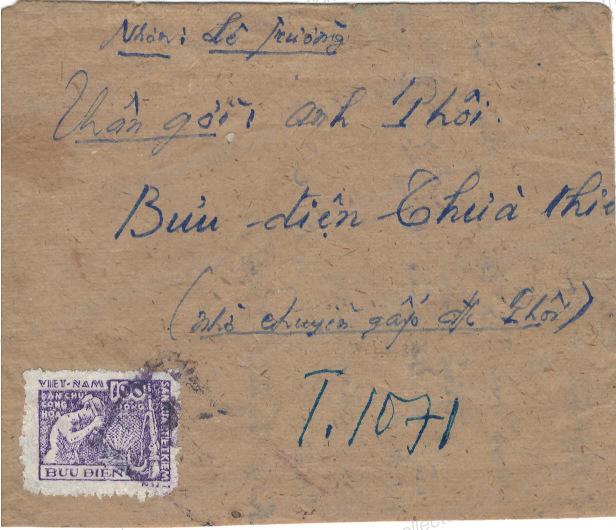
Very rare domestic letter (full contents preserved/4 pages) sent in May of 1955 from Ha Tinh to Phu Ly in Lien Khi 3 . Ha Tinh departure cancel on the reverse. Postage for the standard domestic letter had been increased from 100D to 150D in October of 1954 so this letter was short by 50D but it is not apparent that postage due was collected. The editor does not know how to interpret the blue manuscript “9D”. It may have to do with the postage due issue. The envelope was made up of brownish packing paper (adversity cover). Very few domestic letter from this early area survive.
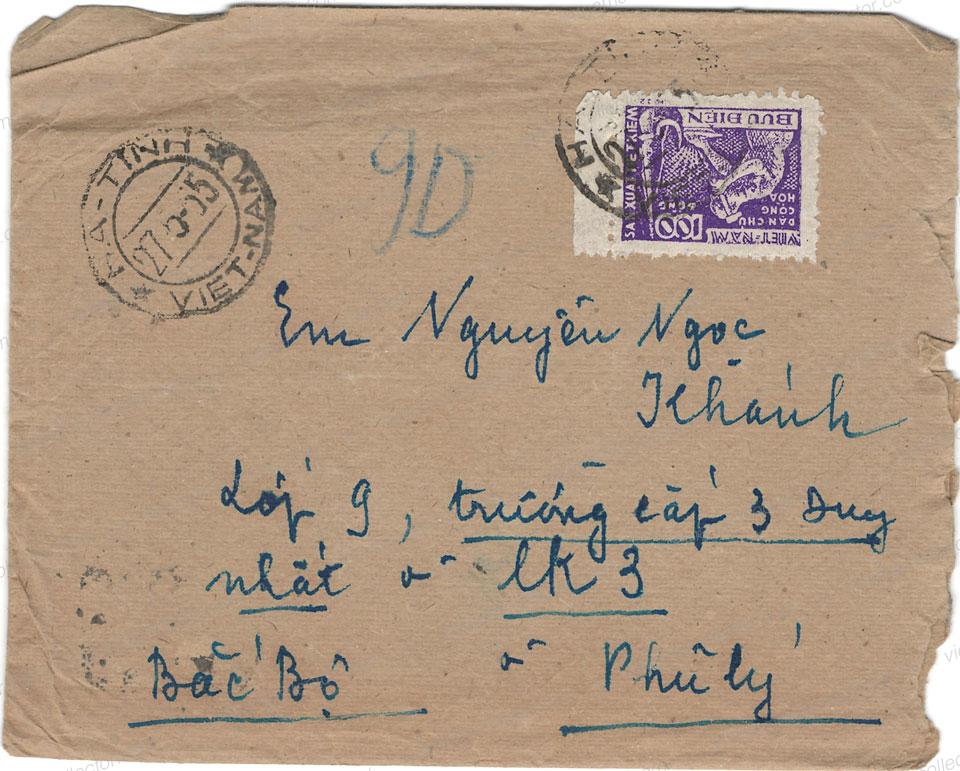
Another very rare local letter mailed in November of 1955 by the cadre for land reform from Son Tay (West of Hanoi) to the Administration of the Presidential Office again paying the correct domestic letter rate of 100 Dong. Domestic postage for a standard letter was reduced from 150D to 100D on July 1st, 1955. The cover is made up of previously used stationary (adversity cover). Illegible arrival cancel on the reverse. Due to the tropical climate, severe material shortages and decades of warfare not many local letters of early North Vietnam survive.

Very rare domestic letter (full contents preserved/3 pages plus greeting card) sent in February of 1956 from Hanoi to Nam Dinh. Nam Dinh arrival cancel on the reverse. Franked with a single 100D Production and Thirst stamp paying the correct standard domestic letter tariff that came in force on July 1st, 1955. The envelope was made up of white writing paper (adversity cover). Very few domestic letter from this early area survive.
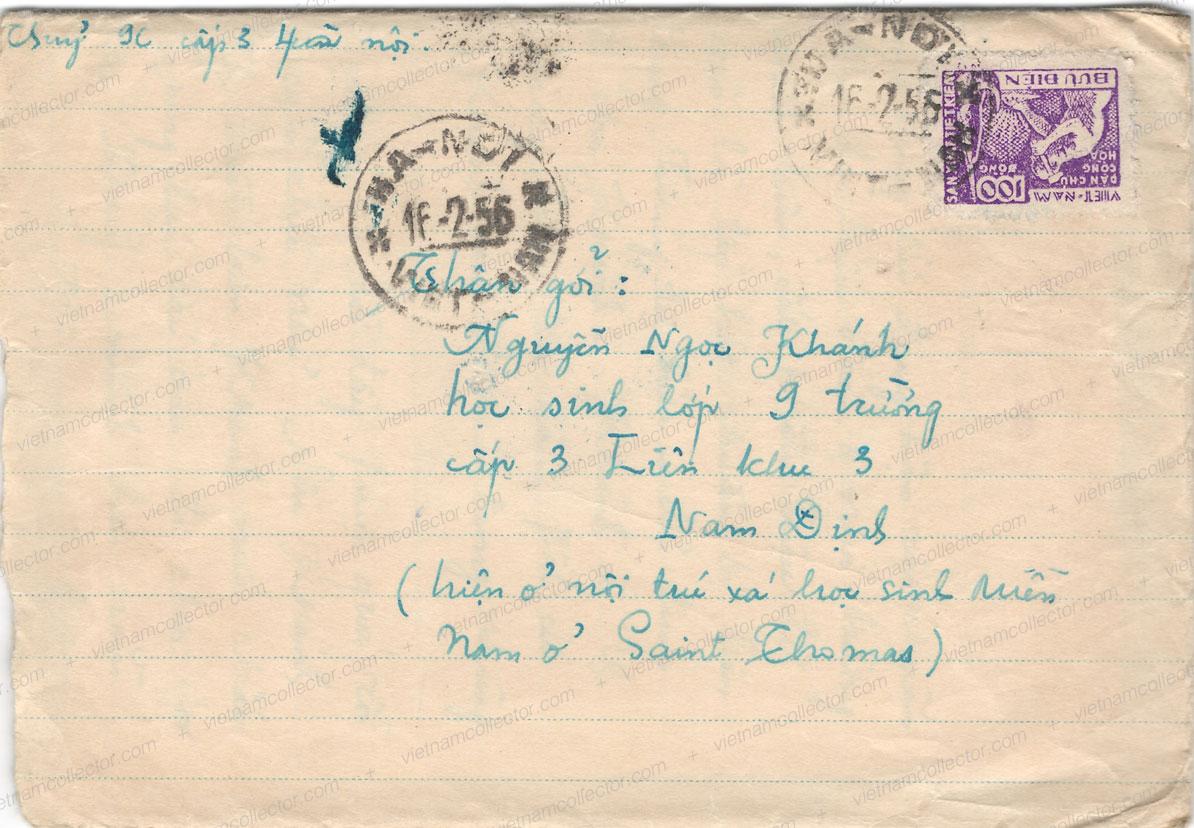
Postcard mailed surface to Hungary featuring a pair of the 100 Dong value for a total of 200mDong in postage that was in force as of March 13th, 1957.
Very rare letter paying the 3rd. domestic weight level and addressed to Prime Minister of the Democratic Republic of Vietnam. The note at the bottom left means ” Please transfer to the Traffic Ministry . If this is not the correct ministry please transfer to the corresponding Government office that dear with the application for an acceptance of the pioneer school.” This is the only third weight level letter the editor has ever seen.
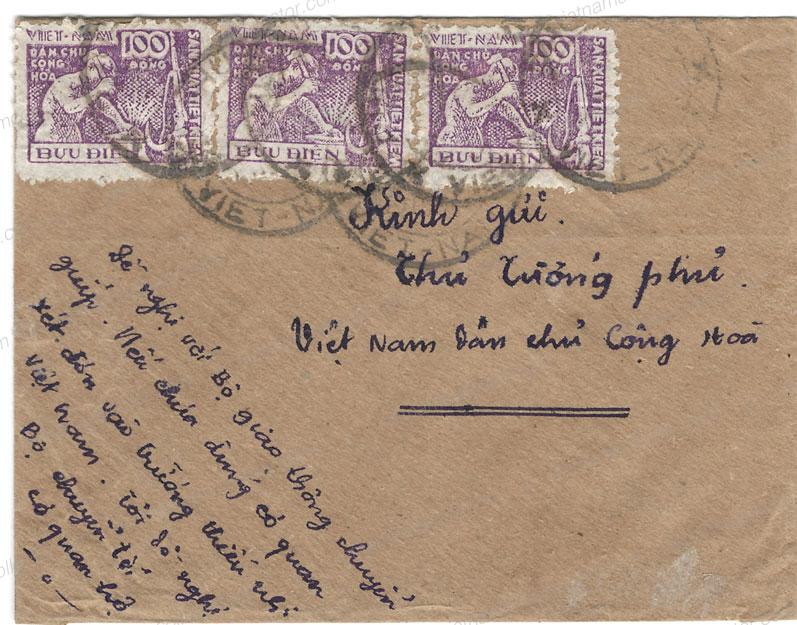
Very early use of the 500D Production and Thrift stamps (2) together with one 100D stamp paying an overall postage of 1,100D on an international air mail letter sent from Hanoi to France in April of 1955 (two months after the 500D had been issued). A letter like this is very unusual in the mid 1950’s as it was not looked kindly upon if North Vietnamese maintained contact with people of the former class-foe France. Letters to fellow socialist countries are much more common.
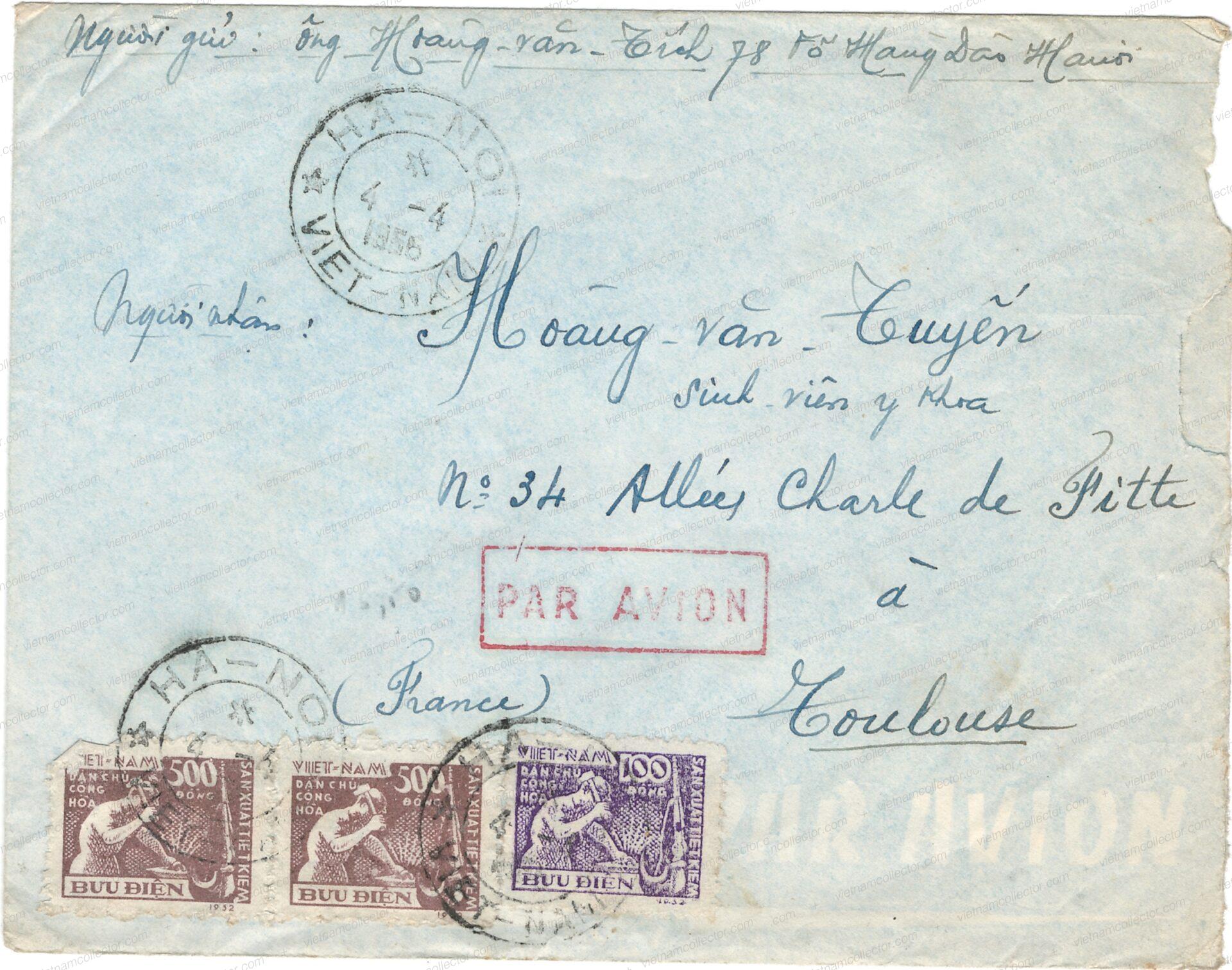
Mixed franking of both Production and Thrift values paying an overall postage of 600D on an international air mail letter (full contents preserved) sent from Hanoi to East Berlin, Germany in January of 1957. The letter was a sent by a member of the East German Embassy.
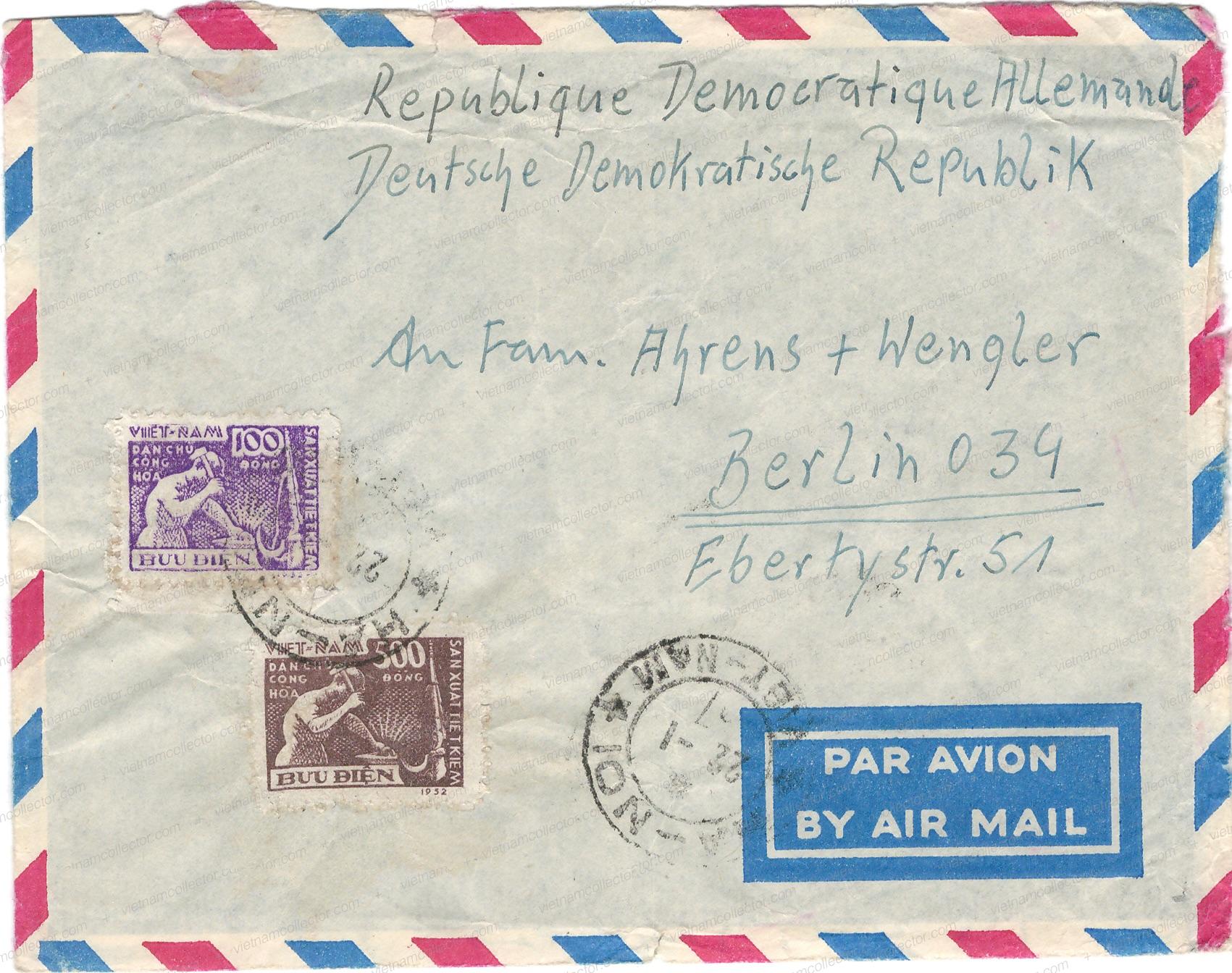
Mixed franking of the 100D Production and Thrift stamp together with the 500D Muc Nam Quan Rail line stamp paying an overall postage of 600D. From July 1st, 1955 through March 13th, 1957 the surface rate to Eastern Germany amounted to 300D and the surcharge for air mail amounted to 270D for every 5 grams of weight so this letter was likely mailed in June of 1955 or 1956 and weighed between 5 and 10 grams.

Mixed franking of the 20D (2) and 50D Agrarian Reform stamps together with stamps from the Production and Thrift and Dien Bien Phu sets paying the standard surface letter rate of 300D in February of 1955. Sent by a member of the East German Embassy to Dresden. The yellow rectangular hand stamp on the left 20D value is a Chinese censor mark that was applied when the letter traversed China en route to the Beijing-Moscow railway.
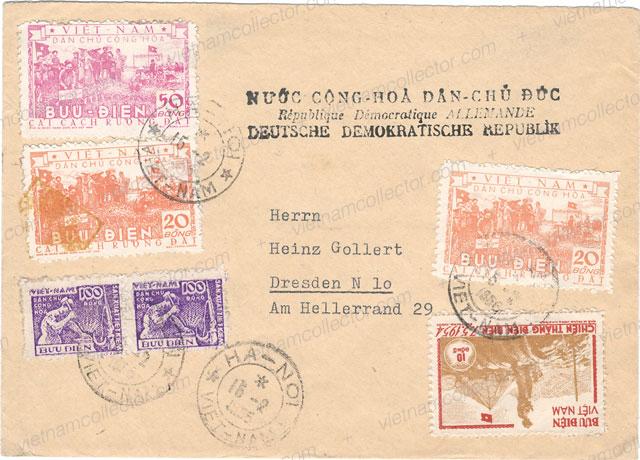
Mixed franking of the 20D and 50D Agrarian Reform stamps together with the 500D Production and Thrift stamp paying an overall postage of 600D on an international air mail letter sent in April of 1956 from Hanoi to East Germany.
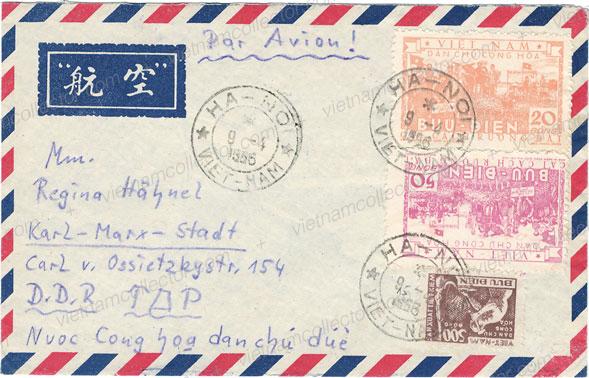
Mixed franking of the 100D Railroad stamp together with the 500D Production and Thrift stamp paying an overall postage of 600D on an international air mail letter sent from a member of the East German Embassy in Hanoi to a family member in Dresden. This was the correct postage for a letter weighing between 5-10 grams. Note the very light color of the railroad stamp.
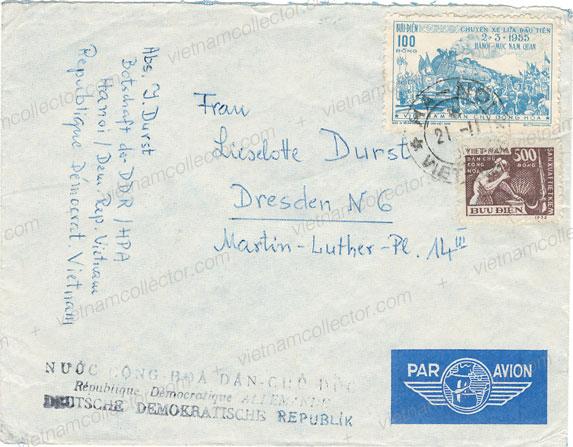
Mixed franking of the 500D Production and Thrift stamp together with the 100D HCM, 20D (2) Tran Dang Ninh and 10D Dien Bien Phu stamp paying an overall postage of 650D on an international air mail letter sent from Hanoi to Czechoslovakia in January of 1958.
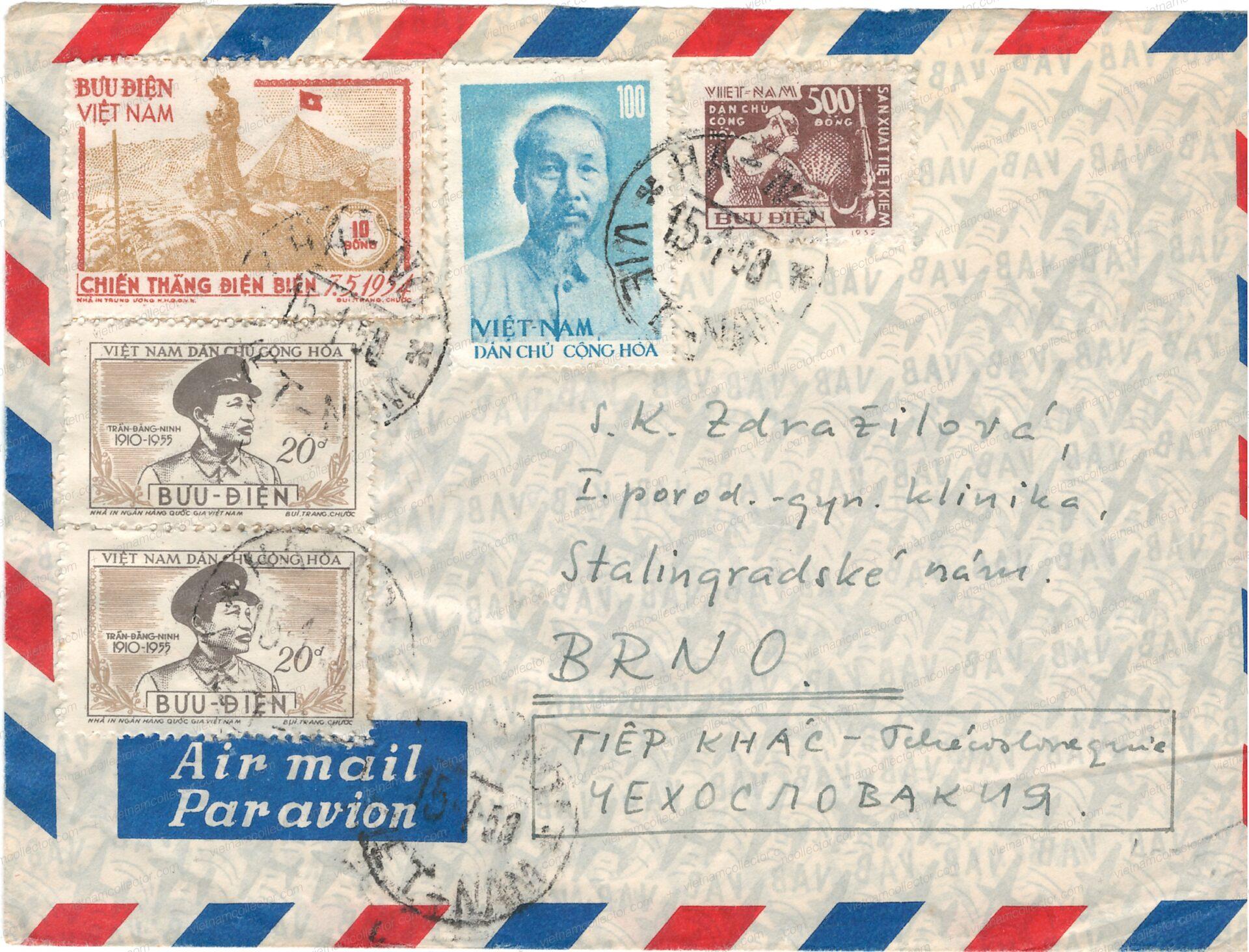
Mixed franking of the 150D imperforate Dien Bien Phu stamp together with the 500D Production and Thrift stamp paying an overall postage of 650D on an international air mail letter sent in May of 1957 from Hanoi to a physician in the world famous Charite’in East Berlin. Postage rates were changed on March 13th, 1957 when the standard surface letter rate amounted to 300D and the air mail surcharge for the first 5g of weight was 350D.
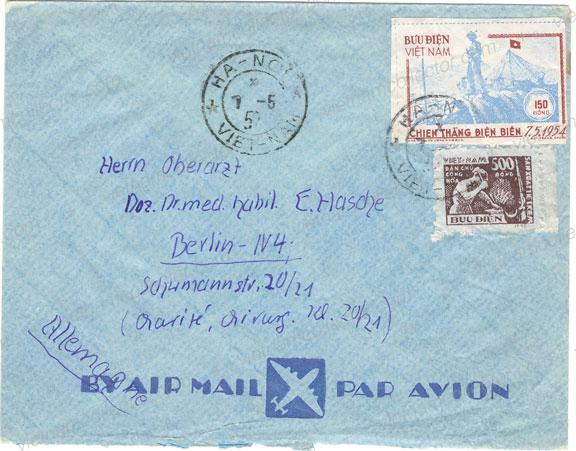
Mixed franking most likely from a member of the East German Consulate (which had access to official stamps) featuring a mix of regular stamps (including the 100D Production and Thrift issue) and two official Union Congress stamps (40D and 100D) for an overall postage of 1,740D. The letter was registered. The basic surface letter rate abroad amounted to 300D, the air mail surcharge to 350D (for every 5g) and the registration fee to 600D. So this letter must have weighed between 10-15g.
Postcard to Czechoslovakia from June, 1956. The 500D post card tariff included a 300D surcharge for the shipment by airmail.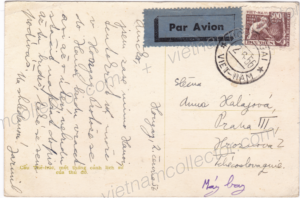
Letter from the Red Cross in Vietnam to the president of the Red Cross in Geneva, Switzerland from April, 1959. The 500 Dong rate shows that postcards and letters required the same postage.
Here is another postcard from January of 1958 which only shows a postage of 550D, made up of a 50D Illiteracy stamp plus one 500D Production and Thrift stamp. The card carries there correct postage (300D base rate in force as of November 1st, 1957 plus 250D air mail surcharge to Hungary).
Mixed franking of both stamps on a letter to China from 1957. The letter base rate to China amounted to 300D, so the 600 Dong rate probably reflects the 2nd weight level. Typical commemorative envelope as was typical for the mid- to late 1950’s.
Military letter from Hom Thu 31.107 in Hanoi to Paris from November, 1957. Military free franks were only valid inside the country so “civilian” stamps had to be used for this international letter. The 1,100 Dong rate to France is obviously much higher than the one to fellow communist countries but the editor has yet to locate a postal tariff to Western countries that reflects the standard letter rate in 1957. North Vietnam letters to Western countries are much rarer in the 1950’s than letters to communist countries as there simply were less business, government and family connections with the West then.
Mixed franking of normal and official stamps (Handicraft stamp from 1958) sent by a member of the Czechoslovakian Embassy (that had access to service stamps) with an overall postage of 950D
The well know philatelist Theo Klewitz had direct contact to a high level official in the North Vietnamese Government. This contact obviously felt secure enough to send him local official letter envelopes despite the prohibition in force. Very few of these local letters survived and hence they are exceedingly scarce. Here are three letters all ex Klewitz. They are all so called adversity covers that were hand-made out of waste paper. Note that the standard letter rate for official mail went from 0.6 kg rice to 1.0 kg rice in February of 1953.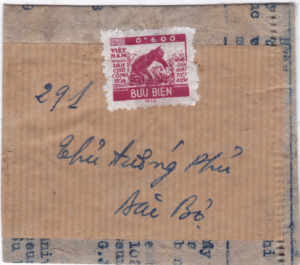
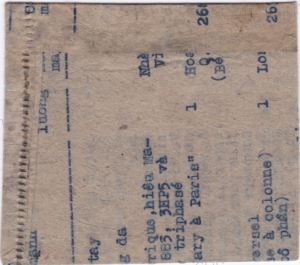
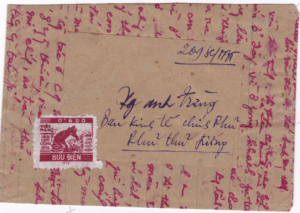
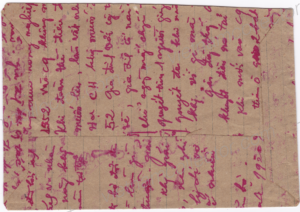

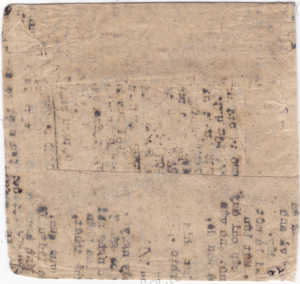
Very rare official letter featuring one of the 0.6kg rice mailed from Lien Khu 3 (3rd administrative District) on September 11th, 1953 to the Control Department 12 (ex Gregor Schwirtz)
Here is an extremely rare international letter carrying one 1.0kg and five of the 5kg stamp mailed in March, of 1957 by the Vietnam Peace Committee to the Austrian Peace Committee in Vienna, Austria. Vienna arrival cancel on the reverse.
Very rare official letter sent in May of 1957 to the Red Cross in Geneva featuring two of the 1kg rice Production and Thrift service stamps plus one of the 80D Agrarian Reform service stamp (thick paper) in a mixed currency franking (kg rice and Dong) and mixed standard/official stamp franking.
Very rare official letter that was sent by the President of the Hanoi Appeals Court to the General Secretary of the Christian Democratic Union Party in East Germany Gerald Goetting. From 1960 until then end of the country in 1989 Goetting was the Assistant President of the highest political body in the country, the “Staatsrat”, which meant he was the second highest official in the land. The letter included a handwritten personal New Year’s greeting and was franked with a mixture of official and standard stamps. The postage was a mixture of the official 1kg Rice stamp together with four 40D official Agrarian Reform stamps (first printing, thin paper)and four standard 10D Dien Bien Phu stamps.
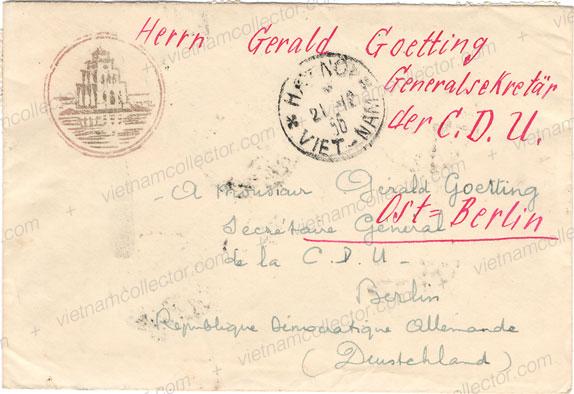
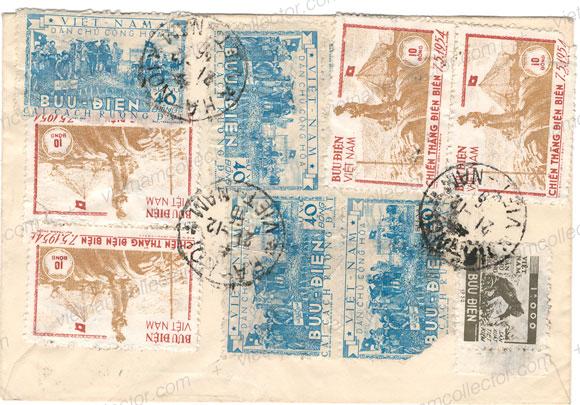
Registration Nr. 100026

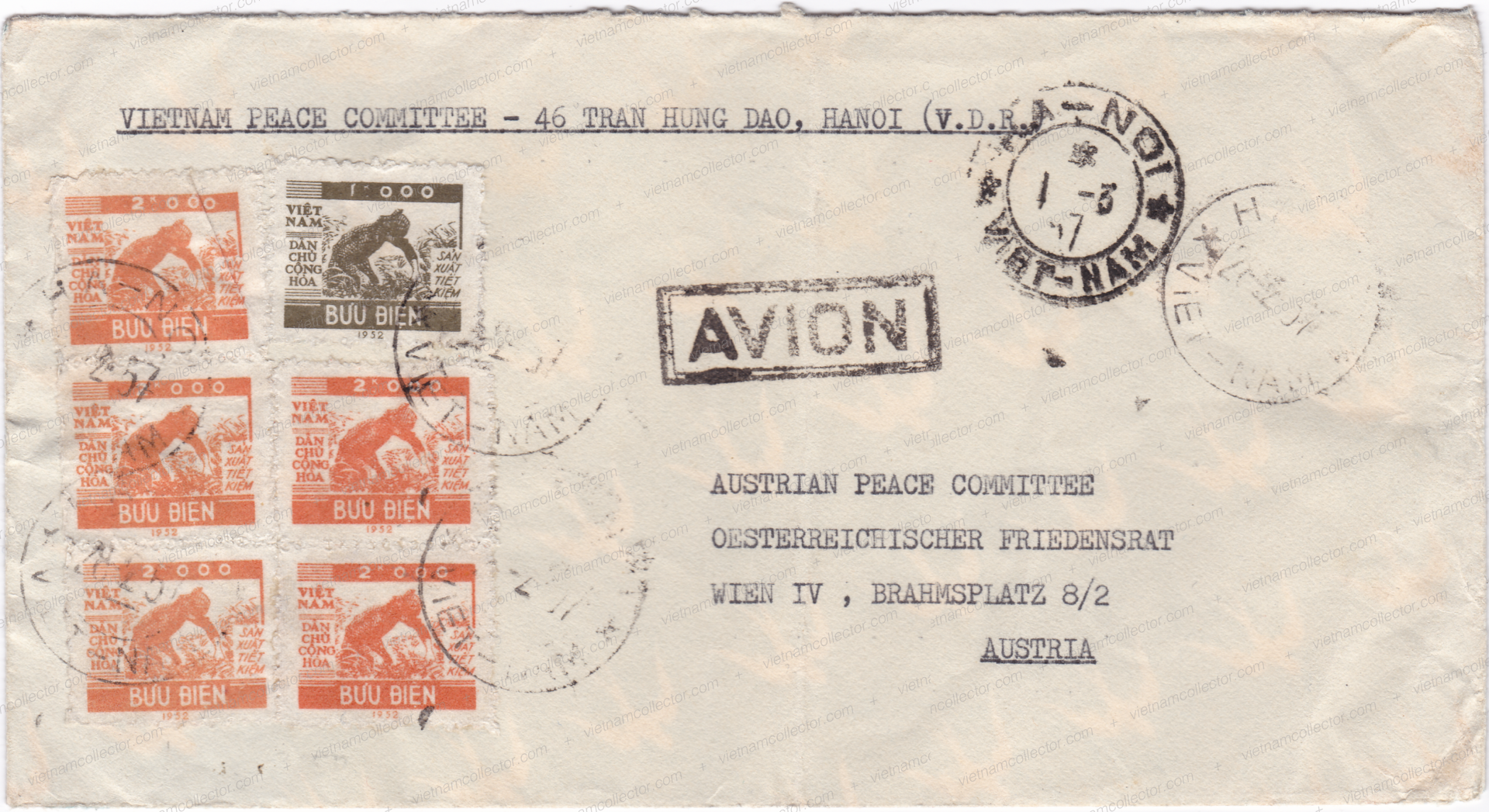
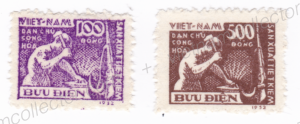
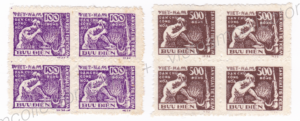

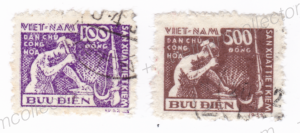
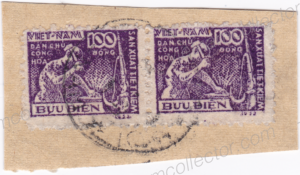
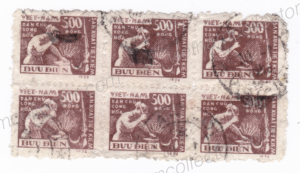
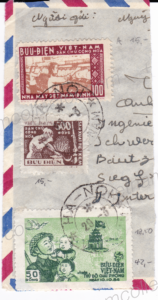

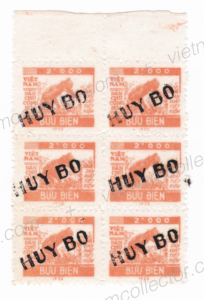
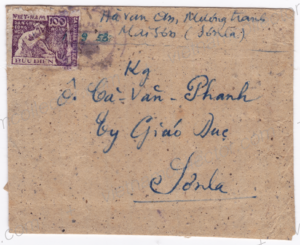
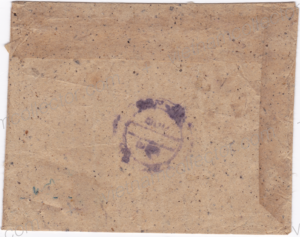

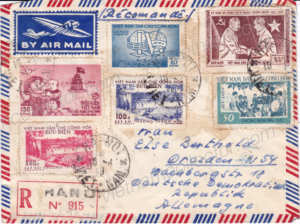
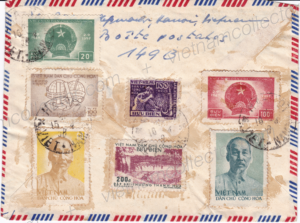
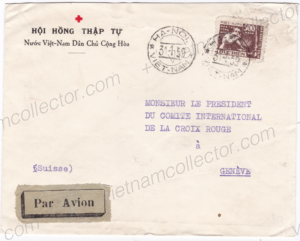
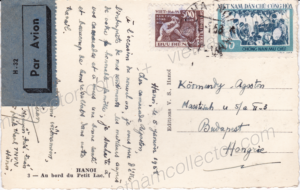
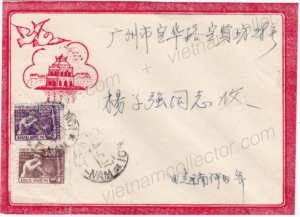

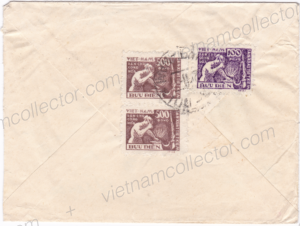
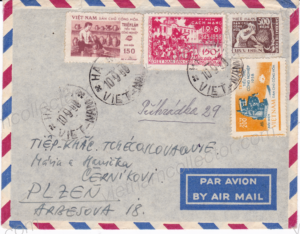
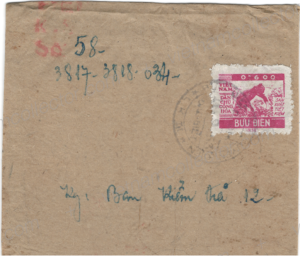
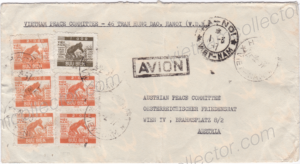
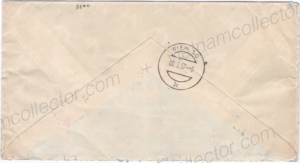
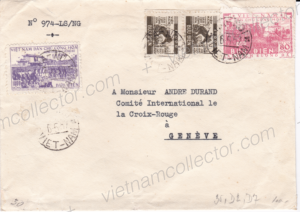
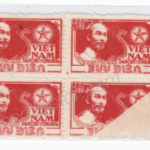
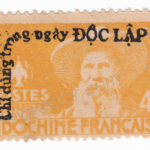


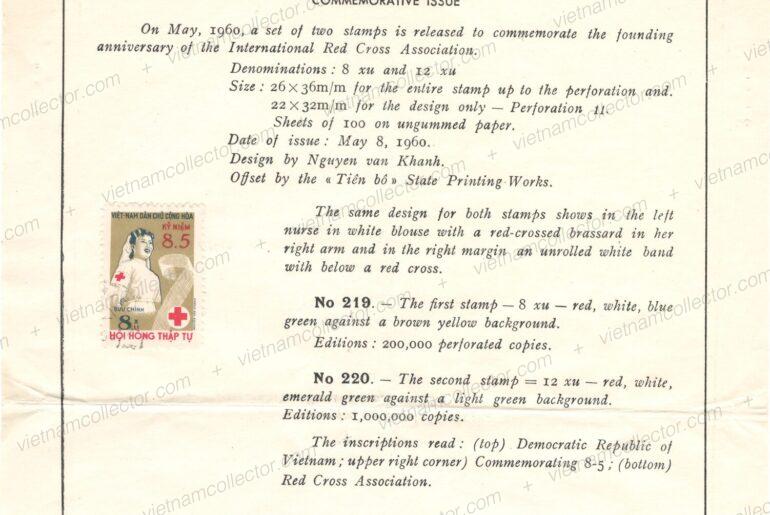
Comments are closed.